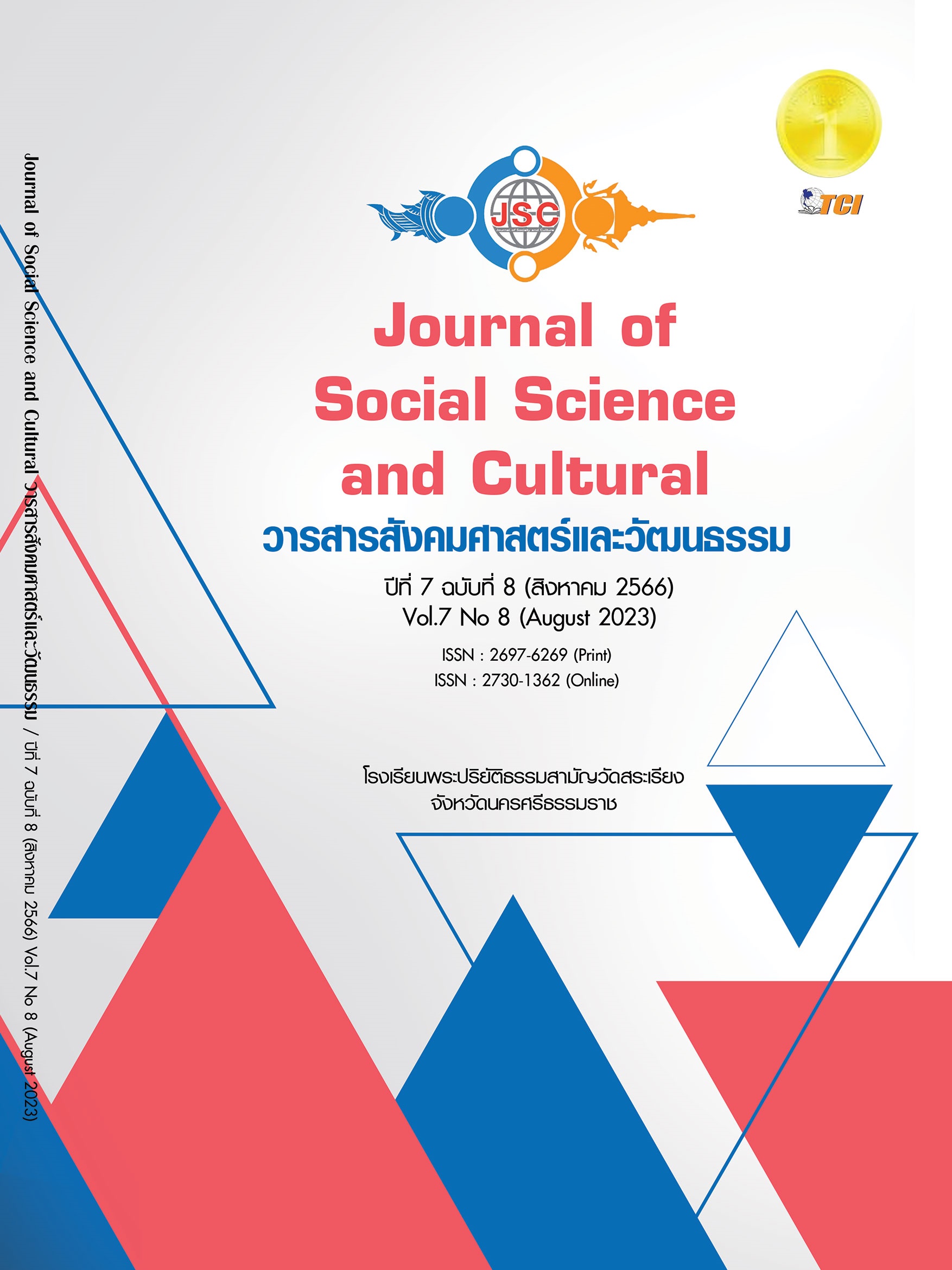THE INFLUENCE OF CASH FLOW ON A COMPANY'S PROFITABILITY LISTED ON THE STOCK EXCHANGE OF THAILAND DURING THE COVID-19
Main Article Content
Abstract
This research aimed to study the influence of cash flow on a company's profitability listed on the Stock Exchange of Thailand during the COVID-19 situation. The secondary data were collected from 157 companies on a yearly basis from 2020 to 2022 by the Panel Data method, comparing to the Fixed Effect Regression Model (FEM) compare with Random Effect Regression Model (REM). The results showed that the appropriate method of estimating the coefficient was to apply the fixed-effect Panel OLS method and the stockholder return rate model. The listed companies on the Stock Exchange of Thailand were suitable (Prob. = 0.0000). The net cash from financing activities (In_CFFi,t) and the number of board of directors influenced the stockholder return rate in the Stock Exchange of Thailand in opposite directions with a statistically significant at 1% and 5% respectively and the R - squared value was 0.7153. When considering the return on capital asset pricing model, the listed companies on the Stock Exchange of Thailand were suitable (Prob. = 0.0000). The net cash from financing activities (ln_CFFi,t) and the number of board of directors influenced the stockholder return rate in the Stock Exchange of Thailand in opposite directions with a statistically significant at 1% and 10% respectively and the R - squared value was 0.7558. Finally, when the net profit margin model was applied with the listed companies on the Stock Exchange of Thailand, it was appropriate (Prob. = 0.0000). The net cash from financing activities (ln_CFFi,t) and the number of board of Directors influenced the net profit margin on the Stock Exchange of Thailand. in opposite directions with a statistically significant at 1% and 5%, respectively and the R - squared value was 0.7558.
Article Details
References
กฤตพงศ์ วัชระนุกุล และกนกอร แก้วประภา. (2558). ความสัมพันธ์ระหว่างข้อมูลองค์ประกอบกำไร และราคาหลักทรัพย์ของบริษัทจดทะเบียนในตลาดหลักทรัพย์แห่งประเทศไทย. วารสารมหาวิทยาลัยทักษิณ, 28(3), 230-249.
กิตติศักดิ์ เคลือบหิรัญ. (2559). ปัจจัยที่มีผลกระทบต่อปริมาณหนี้ที่ไม่ก่อให้เกิดรายได้ของธนาคารพาณิชย์ที่จดทะเบียนในตลาดหลักทรัพย์แห่งประเทศไทย. ใน รายงานการวิจัย. มหาวิทยาลัยกรุงเทพ.
ชลิต ทองดี และภูมิฐาน รังคกูลนุวัฒน์. (2562). ความสัมพันธ์ระหว่างราคาหลักทรัพย์กับการขึ้นเครื่องหมายจ่ายเงินปันผล. ใน การประชุมวิชาการนำเสนอผลงานวิจัยบัณฑิตศึกษาระดับชาติ ครั้งที่ 14. มหาวิทยาลัยหอการค้าไทย.
ชาลินี แสงสร้อย. (2558). ความสัมพันธ์ระหว่างอัตราส่วนทางการเงินกับราคาหลักทรัพย์ของบริษัทจดทะเบียนในตลาดหลักทรัพย์แห่งประเทศไทย: กรณีศึกษากลุ่มอุตสาหกรรมบริการ. ใน สารนิพนธ์วิทยาศาสตรมหาบัณฑิต สาขาวิชาการเงิน. มหาวิทยาลัยกรุงเทพ.
ตลาดหลักทรัพย์แห่งประเทศไทย. (2566). ข้อมูลรายชื่อบริษัท/หลักทรัพย์. เรียกใช้เมื่อ 5 พฤษภาคม 2566 จาก https://www.set.or.th/th/market/get-quote/stock/
ตลาดหลักทรัพย์แห่งประเทศไทย. (2566). มูลค่าตามบัญชี. เรียกใช้เมื่อ 10 พฤษภาคม 2566 จาก https://member.set.or.th/ set/education/glossary.do?contentId=64
ธนาคารกรุงศรีอยุธยา. (2566). บทวิเคราะห์ Research Intelligence ในหัวข้อ COVID-19 Impact on the Thai Economy and Vulnerability of Thai Firms. เรียกใช้เมื่อ 8 พฤษภาคม 2566 จาก https://thaipublica.org/2020/04/krungsri-research-covid19-vulnerability-
thai-firms/
นภดล ร่มโพธิ์. (2553). การศึกษาความสัมพันธ์ระหว่างความสำเร็จของระบบการวัดผลการปฏิบัติงานองค์กรกับความสำเร็จทางการเงิน. วารสารวิชาชีพบัญชี, 6(16), 43-50.
นภสินธุ์ สานติวัตร. (2564). การศึกษาความสัมพันธ์ระหว่างการจ่ายเงินปันผลและการเปลี่ยนแปลงของกำไรในอนาคต. วารสารจุฬาลงกรณ์ธุรกิจปริทัศน์ จุฬาลงกรณ์มหาวิทยาลัย, 43(3) ,1-21.
มนตรี พิริยะกุล. (2566). Panel data analysis. วารสารรามคำแหง มหาวิทยาลัยรามคำแหง, 30(2), 41-54.
วรศักดิ์ ทุมมานนท์. (2560). มิติใหม่ของงบการเงินและการวิเคราะห์. (พิมพ์ครั้งที่ 4). กรุงเทพมหานคร: ธรรมนิติเพรส.
อภิญญา สินจรูญศักดิ์. (2550). ความสัมพันธ์ระหว่างกำไรสุทธิ, กระแสเงินสดจากกิจกรรมดำเนินงาน,สินทรัพย์สุทธิกับกำไรในอนาคตของบริษัทจดทะเบียนในตลาดหลักทรัพย์แห่งประเทศไทย. ใน สารนิพนธ์บัญชีมหาบัณฑิต สาขาวิชาการบัญชี. มหาวิทยาลัยรังสิต.
Bhattacharya, S. (1979). Imperfect Information, Dividend Policy, and "The Bird in the Hand" Fallacy. The Bell Journal of Economics, 10(1), 259-270.
Hair, J. F. et al. (2010). Multivariate Data Analysis. (7th ed.). Upper Saddle River, NJ: Prentice Hall.
James, G. et al. (2017). An Introduction to Statistical Learning: With Applications in R. (Spring Texts in Atatistics). (7th Ed.). New York: Springer.
Lintner, J. (1956). Distribution of Incomes of Corporations Among Dividends, Retained Earnings, and Taxes. The American Economic Review, 46(2), 97-113.
Loughran, T. & Ritter, J. R. (1997). The operating performance of firms conducting seasoned equity offerings. The journal of finance, 52(5), 1823-1850.
Luu, T. V. et al. (2008). Performance measurement of construction firms in developing countries. Construction management and economics, 26(4), 373-386.


